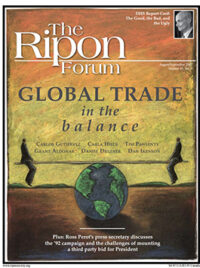Although the United States has the safest food supply in the world, the American public is beginning to wonder whether or not they can trust the brands they buy and the food they eat. From spinach to pet food, recent events have shaken public confidence in the safety and security of our nation’s food supply. That should come as no surprise, because the safety and security of our food supply affects the health and well-being of each and every American, as well as millions of people around the globe.

By its very nature, our food supply constantly evolves in reaction to changes in consumer preferences, new processing and packaging technology, and breaking news in the area of food science. For instance, who would have predicted 20 years ago that fresh and organic foods would be one of the fastest growing segments in retail food today? Despite the challenges that come along with these changes, the food industry has quickly adapted to give consumers what they want – safe and affordable foods that meet their lifestyles.
The safety and security of our food supply is the shared responsibility of policymakers, regulators and the food industry. For industry’s part, food safety is paramount. Nothing we do would be possible if consumers are not able to trust that the brands they love and the foods they eat are safe.
In addition, government regulatory agencies at the federal, state and local levels work hard every day to ensure we have a safe and secure food supply. Two federal agencies – the U.S. Department of Agriculture (USDA) and the U.S. Food and Drug Administration (FDA) are primarily responsible for food safety.
Since its inception, the FDA has been the principal protector of most of our food supply. However, the Agency is at a critical crossroads. Inadequate funding has undermined the Agency’s resources and its ability to protect the food we eat. In fact, FDA’s funding has failed to keep pace with inflation, let alone the rapidly changing pace of food science.
Based on current projections, by the end of fiscal year 2007, the Agency’s funding will have fallen 30 percent behind inflation over the past five years, and food-related staff will have suffered a 15 percent cut. That means a shortage of 1,000 experts to conduct scientific evaluations of new foods or ingredients and to inspect imported fruits and vegetables. In comparison, funding for other national health agencies, such as the Centers for Disease Control, has grown much faster than inflation.
Traditionally, the FDA has been able to adapt to meet new and emerging threats. But now, the agency is confronting an ever expanding scope of threats with increasingly shrinking resources. From contaminant outbreaks, a growing number of imports and food labeling challenges to product approvals and health and wellness, emerging issues have placed increasing demands on the FDA, making it hard for the Agency to keep pace.
To truly protect the American public, the FDA must have the resources it needs, not only to quickly respond to food emergencies, but to prevent the crisis from happening in the first place. That is why a broad coalition of stakeholders, including the food industry, has formed the Coalition for a Stronger FDA, with the goal of doubling the Agency’s food safety budget over the next five years.
In addition, industry is working with Congressional leaders and regulatory agencies to identify any weaknesses in our nation’s food safety net, and put in place new strategies to confront them. In fact, industry is working with a recently appointed White House working group tasked with researching our food safety infrastructure and making recommendations for improving the safety of our food supply – especially the safety of foods from overseas.
To truly protect the American public, the FDA must have the resources it needs, not only to quickly respond to food emergencies, but to prevent the crisis from happening in the first place.
But food safety is not just about government oversight and enforcement. Our food companies are some of America’s most respected businesses for a good reason – they work hard to earn the trust of their consumers. That trust is not possible without an understanding that they provide consumers with safe products.
On an ongoing basis – and in response to recent events – food manufacturers constantly verify, update and modernize their food safety procedures. Whenever necessary, they ramp-up inspections, conduct audits, switch to alternate suppliers, conduct recalls and do whatever is necessary to ensure the quality and safety of their products.
Despite recent events, the number of food-related deaths, illnesses, outbreaks and contaminations has declined steadily over the last decade. That is a trend that everyone, including food manufacturers, policymakers and consumers, wants to see continue for another decade.
As we seek our goal of a zerorisk food supply, both government and industry must remain vigilant, and constantly “think outside the box” when it comes to food safety. And, when problems are identified – both large and small – they must react swiftly to identify the problem, address any weaknesses and reassure the public in the safety and security of our food supply. That is the game plan for success.
Mary Sophos is the Senior Vice President and Chief Government Affairs Officer of the Grocery Manufacturers/Food Products Association.




